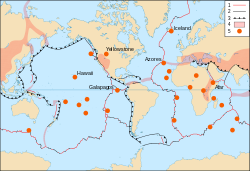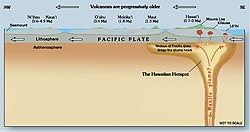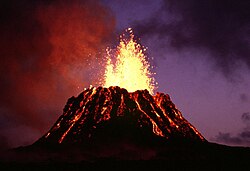Hotspot (geology)


In geology, a hotspot or hot spot is a portion of the Earth's surface which is volcanic. This may be caused by a rising mantle plume or some other cause.[2] Hotspots may be far from tectonic plate boundaries.
A volcanic hotspot is where magma pushes up from deep in the Earth's crust or mantle, and creates a volcano. The Earth's plates may move along, creating a new volcano above the hotspot while moving the older volcanoes away. This creates a chain of islands, such as in Hawaii.
Discussion
Standard account of volcanic activity
Most volcanoes are explained by the collision or splitting apart of continental plates. This explains the long mountain ranges which have many volcanoes, such as the western edge of the Americas. It also explains the huge rift valleys such as the East African Rift Valley. Most Earth scientists accept that the cause of these great features is plate tectonics.
The problem arises with volcanoes which are not at the edges of plates. In the United States, the Yellowstone Caldera is obviously active. It has geysers caused by constant geothermal energy activity, and the floor of the crater moves up and down as much as 50 meters in a few years. The Pacific Ocean has six or seven chains of islands formed by volcanic activity. Most of these cannot be explained simply as being on the edge of two or three plates.
Hotspot theory
J. Tuzo Wilson suggested in 1963 that volcanic chains like the Hawaiian Islands result from the slow movement of a tectonic plate across a fixed hot spot deep beneath the surface of the planet.[3] Hotspots are thought to be caused by a narrow stream of hot mantle convecting up from the Earth's core–mantle boundary called a mantle plume.[4]
Other geologists think it is not high temperature that causes the volcanism. They think lithospheric extension (stretching of the Earth's crust) allows melted mantle to rise from shallow depths.[2][5][6][7]
Geologists have identified some 40–50 such hotspots around the globe. Those under Hawaii, Réunion, and Yellowstone are the most active at present.
Hotspot (geology) Media
Diagram showing a cross section through Earth at the Hawaii hotspot. Magma originating in the mantle rises into the asthenosphere and lithosphere. A chain of volcanoes is created as the lithosphere moves over the source of magma. ("Ma" means millions of years old/ago).
Prominent hotspot trails on a bathymetric map of the Pacific Ocean
Over millions of years, the Pacific plate has moved over the Hawaii hotspot, creating a trail of underwater mountains that stretches across the Pacific.
Kilauea is the most active shield volcano in the world. The volcano erupted from 1983 to 2018 and is part of the Hawaiian–Emperor seamount chain.
Mauna Loa is a large shield volcano. Its last eruption was in 2022 and it is part of the Hawaiian–Emperor seamount chain.
Bowie Seamount is a dormant submarine volcano and part of the Kodiak-Bowie Seamount chain.
Axial Seamount is the youngest seamount of the Cobb–Eickelberg Seamount chain. Its last eruption was in 2015.
Mauna Kea is the tallest volcano in the Hawaiian–Emperor seamount chain. Many cinder cones have been emplaced around its summit.
References
- ↑ Courtillot V. et al 2003. Three distinct types of hotspots in the Earth's mantle (2003). "Three distinct types of hotspots in the Earth's mantle". Earth Sci. Planet. Lett. 205 (3–4): 295–308. Bibcode:2003E&PSL.205..295C. doi:10.1016/S0012-821X(02)01048-8.
- ↑ 2.0 2.1 "Do plumes exist?". Archived from the original on 2011-01-19. Retrieved 2010-04-25.
- ↑ J. Tuzo Wilson 1963. A possible origin of the Hawaiian Islands (1963). "A possible origin of the Hawaiian Islands" (PDF). Canadian Journal of Physics. 41 (6): 863–870. Bibcode:1963CaJPh..41..863W. doi:10.1139/p63-094.
- ↑ "Hotspots: mantle thermal plumes". United States Geological Survey. 1999-05-05. Retrieved 2008-05-15.
- ↑ Foulger G.R. 2010 (4 October 2010). Plates vs plumes: a geological controversy. Wiley-Blackwell. ISBN 978-1-4051-6148-0. Archived from the original on 25 November 2017. Retrieved 4 October 2013.
- ↑ Wright, Laura 2000. Earth's interior: raising hot spots. "Geotimes - November 2000: New Notes". Geotimes. Retrieved 2008-06-15.
- ↑ Christiansen, Robert L; Foulger G.R. and Evans, John R. 2002. Upper-mantle origin of the Yellowstone hotspot (2002). "Upper-mantle origin of the Yellowstone hotspot" (PDF). GSA Bulletin. 114 (10): 1245–1256. Bibcode:2002GSAB..114.1245C. doi:10.1130/0016-7606(2002)114<1245:UMOOTY>2.0.CO;2. Retrieved 2008-06-15.
{{cite journal}}: CS1 maint: multiple names: authors list (link)










